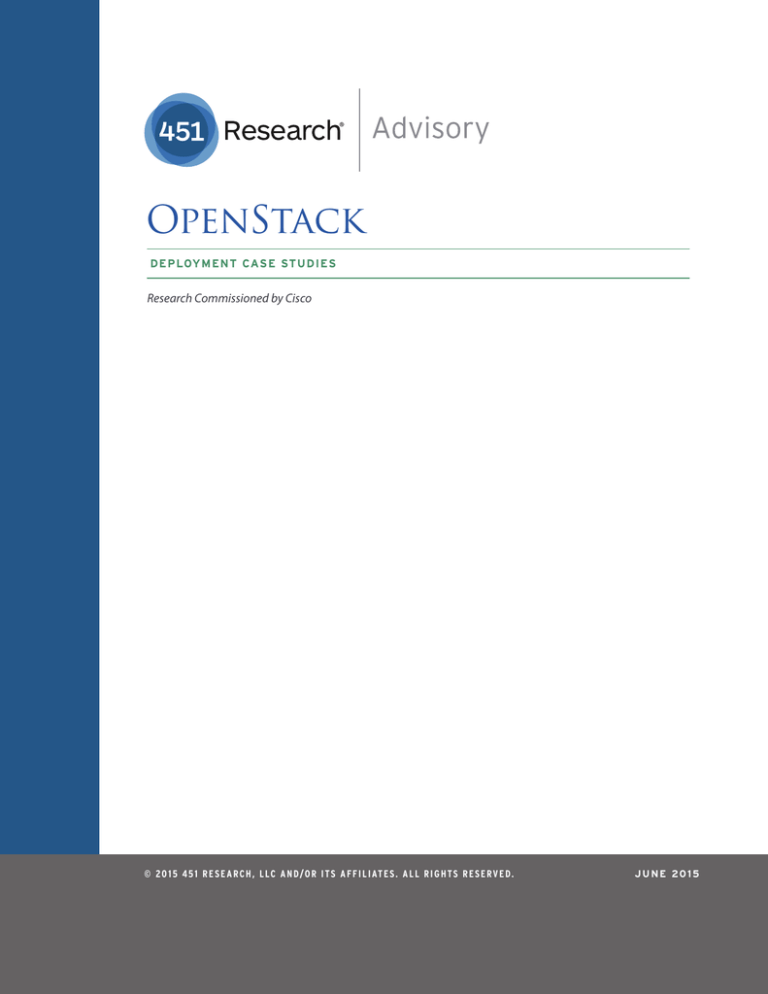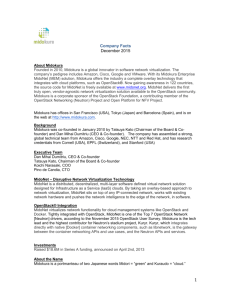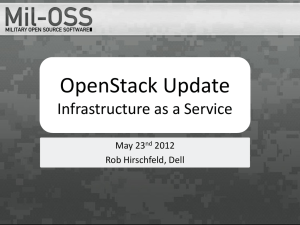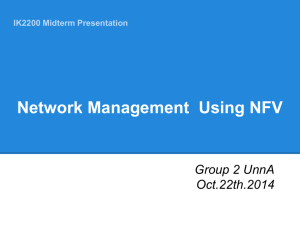
OpenStack
DEPLOYMENT CASE STUDIES
Research Commissioned by Cisco
© 20 1 5 4 5 1 R E S E A R C H , L LC A N D/O R I T S A F F I L I AT E S . A L L R I G H T S R E S E R V E D.
JUNE 2015
i
451 RESEARCH
ABOUT 451 RESEARCH
451 Research is a preeminent information technology research and advisory company.
With a core focus on technology innovation and market disruption, we provide essential
insight for leaders of the digital economy. More than 100 analysts and consultants
deliver that insight via syndicated research, advisory services and live events to over
1,000 client organizations in North America, Europe and around the world. Founded in
2000 and headquartered in New York, 451 Research is a division of The 451 Group.
© 2015 451 Research, LLC and/or its Affiliates. All Rights Reserved. Reproduction and distribution of
this publication, in whole or in part, in any form without prior written permission is forbidden. The
terms of use regarding distribution, both internally and externally, shall be governed by the terms
laid out in your Service Agreement with 451 Research and/or its Affiliates. The information contained
herein has been obtained from sources believed to be reliable. 451 Research disclaims all warranties as
to the accuracy, completeness or adequacy of such information. Although 451 Research may discuss
legal issues related to the information technology business, 451 Research does not provide legal
advice or services and their research should not be construed or used as such. 451 Research shall have
no liability for errors, omissions or inadequacies in the information contained herein or for interpretations thereof. The reader assumes sole responsibility for the selection of these materials to achieve its
intended results. The opinions expressed herein are subject to change without notice.
New York
London
20 West 37th Street, 6th Floor
New York, NY 10018
Phone: 212.505.3030
Fax: 212.505.2630
Paxton House (5th floor), 30 Artillery Lane
London, E1 7LS, UK
Phone: +44 (0) 207 426 0219
Fax: +44 (0) 207 426 4698
San Francisco
Boston
140 Geary Street, 9th Floor
San Francisco, CA 94108
Phone: 415.989.1555
Fax: 415.989.1558
1 Liberty Square, 5th Floor
Boston, MA 02109
Phone: 617.275.8818
Fax: 617.261.0688
© 2015 451 RESEARCH, LLC AND/OR ITS AFFILIATES. ALL RIGHTS RESERVED.
OpenStack
ii TABLE OF CONTENTS
INTRODUCTION1
EXECUTIVE SUMMARY 1
USER DEPLOYMENT CASES
2
USE CASE 1: REPATRIATING APPLICATIONS FROM AWS TO IMPROVE DEVOPS . . . . 2
USE CASE 2: THIRD-GENERATION OPENSTACK CLOUD FOR COST SAVINGS
AND FUTURE FLEXIBILITY . . . . . . . . . . . . . . . . . . . . . . . . . . . 3
USE CASE 3: BUILD A PRIVATE CLOUD THAT WORKS LIKE PUBLIC CLOUD . . . . . . 5
USE CASE 4: TRANSFORM IT INTO AN INTERNAL CLOUD PROVIDER . . . . . . . . .7
USE CASE 5: BUILD AN INFRASTRUCTURE LAYER AS DYNAMIC AS
THE APPLICATION LAYER . . . . . . . . . . . . . . . . . . . . . . . . . . . 9
FINAL THOUGHTS
11
USE CASE FEEDBACK SUMMARY . . . . . . . . . . . . . . . . . . . . . . . . . 11
© 2015 451 RESEARCH, LLC AND/OR ITS AFFILIATES. ALL RIGHTS RESERVED.
1
451 RESEARCH
INTRODUCTION
OpenStack has emerged as an open-source platform to build and operate private and
public cloud environments. In a relatively short time, it has gained a great deal of interest
from hardware and software vendors, service providers, the investment community and, as
illustrated in this report, large enterprises with complex hybrid environments.
As more developers and end users have united to build out OpenStack’s capabilities,
momentum has increased. Leading use cases include ‘big data’ and DevOps, the new discipline emerging in enterprises that drives more agile and rapid deployment of applications.
Both big data and DevOps leverage the flexibility and integration inherent in OpenStack.
In the early days of OpenStack, established vendors and startups alike were mainly focused
on providing IT services for the development and testing of new cloud-based applications.
As companies adopt cloud more widely, they will support more robust DevOps initiatives.
451 Research’s Market Monitor service expects total OpenStack-related revenue to exceed
$1.7bn by 2016, and $3bn by 2018.
EXECUTIVE SUMMARY
In this report prepared for Cisco, 451 Research documents five OpenStack use cases
with large enterprise users – one of the largest global airlines, a big-data provider, a fastgrowing gaming company, a large and diversified insurance company, and a well-known
analytics software provider.
While the use cases presented here are not necessarily representative of the entire market,
the themes inherent in these use cases will resonate with individuals who are following the
evolution of OpenStack.
Specifically, the organizations examined here are using OpenStack to:
• Enable DevOps
• Add flexibility to their infrastructure
• Improve cost controls
• Avoid vendor lock-in
• Optimize hybrid private/public cloud deployments
Chasing these benefits is not without challenges, including:
• Inconsistent documentation
• Lack of skill sets
• Multiple distribution choices
• Immature technology
© 2015 451 RESEARCH, LLC AND/OR ITS AFFILIATES. ALL RIGHTS RESERVED.
OpenStack
2
USER DEPLOYMENT CASES
USE CASE 1: REPATRIATING APPLICATIONS FROM AWS TO
IMPROVE DEVOPS
Background
Ubisoft, a French software game developer and publisher, is the third-largest company of
its kind globally. Publisher of popular titles like ‘Assassin’s Creed’ and ‘Splinter Cell,’ Ubisoft
has roughly 9,281 employees, and reported revenue of just over $1bn in 2014.
Business Objective
Ubisoft is seeking infrastructure that is more agile, which can be integrated with its
existing environments, and can be fully under its control. This is driven by Ubisoft’s plan
to repatriate applications from Amazon Web Services (AWS) and migrate the development and maintenance of these applications to an internal datacenter. These applications
include free games, social network games, matchmaking services for players, and a log
aggregation service similar to Splunk. Additionally, internal Web services development
and testing functions will be supported. In short, Ubisoft is embracing DevOps and sees
OpenStack as an enabling technology for this purpose.
Key technologies in Ubisoft’s OpenStack deployment include (EMC’s) Cloudscaling Open
Cloud System (OCS), RightScale cloud management, and Ubisoft’s own tools built on top
of OCS to monitor capacity management and bill-back.
OpenStack Drivers and Deployment
Ubisoft notes that many of its developers were using AWS and realizing measurable
advantages in areas such as cost, innovation and time to market with new apps. While
the company agrees that the AWS blueprint and model are solid, Ubisoft realized that to
meet its goals it needed to build these capabilities internally. In addition, the company
wanted to start with a clean slate rather than extending traditional hypervisors. To some
extent, Ubisoft was trying to tame ‘shadow IT’ activity. Ultimately, building a new footprint for next-gen DevOps on open-source technologies made the most sense.
Challenges
Ubisoft is quick to point out that OpenStack implementation is not always easy. Before
engaging Cloudscaling, the company encountered challenges with its own DIY OpenStack implementation. Instead of going the DIY route, Ubisoft recommends selecting a
vendor whose core focus is OpenStack. Ubisoft realized it was critical to have a partner
that could work with and augment its internal team, to fill in the open-source skills gaps
evident within the organization. Ubisoft remains concerned about the challenge of
upgrading OpenStack.
© 2015 451 RESEARCH, LLC AND/OR ITS AFFILIATES. ALL RIGHTS RESERVED.
3
451 RESEARCH
Benefits
While building cloud infrastructure is a nontrivial undertaking, Ubisoft has seen improved time
to market, productivity and cost performance. The company is redeveloping technology and
human capital capabilities and evolving its infrastructure beyond traditional hypervisors and
other legacy technology. This has resulted in improved time to market and developer productivity, which are the hallmarks of successful DevOps implementations. Ubisoft adds that cost
is almost a non-issue right now because cloud infrastructure keeps getting cheaper, and will
continue to do so. Ubisoft also sees the freedom and potential to innovate with OpenStack as
a major benefit. Cloud infrastructure and DevOps are new to many internal groups, which are
just now ramping up with OpenStack, so even further benefits may be found.
Words of Advice
Ubisoft cautions others to never underestimate the amount of work it will take to implement OpenStack, and to make sure teams are cloud-ready and have the ability to implement
DevOps. Many changes are required, and companies need to work with a vendor that can truly
partner with them on the journey. “They need to become part of your staff,” Ubisoft comments.
On the technical side, Ubisoft stresses that cloud efforts must integrate with existing infrastructure and processes. “You don’t want to start building more silos in your organization, especially
in a company that is global and highly distributed.”
USE CASE 2: THIRD-GENERATION OPENSTACK CLOUD FOR COST
SAVINGS AND FUTURE FLEXIBILITY
Background
This case involves a national insurance company that provides medical, dental, life and
disability insurance services to over 40 million people. It has about 35,000 employees, of which
350 are dedicated to IT.
Business Objective
The insurance company built out its third-generation internal private cloud based on a CIO
mandate to leverage OpenStack and reduce hardware costs as “management was looking for
every possible nickel they could squeeze out of the infrastructure.” It had built version 2.0 of
its private cloud with CloudStack initially as a DevOps proof-of-concept using hardware that
was already available in the datacenter. The company wanted to ensure that the 2.0 cloud was
viable and could efficiently support developers and the faster iteration cycles and continuous
deployment functions of DevOps. This version also relied heavily on PuppetLabs’ DevOps tools,
as IT leadership set a goal to automate functions wherever appropriate.
As the insurance company planned version 3.0, it required a complete server and storage hardware refresh, and the CIO mandated the use of OpenStack. After the 2.0 environment was shut
down, the company began migrating more Linux-based applications to the OpenStack environment, and it expects most Linux and Windows applications to move over in future.
© 2015 451 RESEARCH, LLC AND/OR ITS AFFILIATES. ALL RIGHTS RESERVED.
OpenStack
4
OpenStack Drivers and Deployment
The initial catalyst for the move to OpenStack was IT management’s desire to use an open
architecture, and their belief that OpenStack had more momentum in the market than
CloudStack. While the IT operations team thought its earlier CloudStack environment was
functioning well, management wanted to ensure that the 3.0 private cloud was ‘future
proof’ and capable of supporting DevOps. The initial OpenStack-based 3.0 cloud was built
from 25 8-core physical servers, as well as SAN and NAS systems.
Approximately five IT staff members were dedicated to the project, and another seven
were involved on a non-dedicated basis. Since there was no in-house OpenStack expertise,
the company decided to contract for services from its OpenStack distribution provider.
Challenges
The insurance company relied heavily on the support of its chosen OpenStack distribution
vendor for the initial configuration and installation, due to the lack of in-house knowledge.
Fortunately, the company found few functional differences between OpenStack and CloudStack. The challenges were in some of the subtle differences in the software. Migrating
management and monitoring tools to the new OpenStack dashboard and integrating the
Neutron networking module with the existing network were the areas that required additional time and effort.
Overall, a supported OpenStack distribution shielded the operations team from many of
the complexities of OpenStack. This highlights the benefits of such an approach to organizations seeking help in implementing a DevOps strategy, particularly given the growing
demand for faster software releases and more efficient IT operations.
Benefits
From the time that all of the new hardware was on-site, the installation, configuration and
troubleshooting efforts took 60 days until the first instance was live. The company feels
that it now has a more robust, open environment with a thriving community. Its 3.0 architecture provisions infrastructure in the same amount of time, but the change from the 2.0
environment allows for greater competition and choice when it comes time for future software upgrades or technology refreshes.
Words of Advice
The company advises that enterprises pursuing a similar wholesale change learn all they
can about OpenStack prior to deployment, and that they move slowly and have a wellthought-out migration plan. Using a vendor-supported OpenStack distribution proved
to be invaluable, but the company still had challenges investigating hardware and software configuration issues, commenting that “If we had brought in all of the hardware and
proved it worked in our existing environment, then we would have known the problem is
likely with the software. If you don’t know where your problems are, you spend an inordinate amount of time trying to debug things.”
© 2015 451 RESEARCH, LLC AND/OR ITS AFFILIATES. ALL RIGHTS RESERVED.
5
451 RESEARCH
USE CASE 3: BUILD A PRIVATE CLOUD THAT WORKS LIKE
PUBLIC CLOUD
Background
Tapjoy provides a mobile advertising and monetization platform that is based on bigdata infrastructure, which consists of technologies such as Hadoop, HBase, MemSQL and
a suite of Java applications that do myriad jobs.
Business Objective
Tapjoy needed to scale its big-data infrastructure in a cost-effective, efficient manner. This
prompted a reevaluation and reinvestment strategy.
The company’s original OpenStack deployment replaced bare-metal servers running IBM
SoftLayer with a virtualized OpenStack environment – its first non-AWS virtualization platform. There was not much need for a proof-of-concept because the first big-data project
was fairly generic, and was picked specifically because it would require minimal use of
OpenStack tools.
Tapjoy focused mainly on the Nova compute component of OpenStack and did not
initially consider taking on more complex pieces of OpenStack. However, once Tapjoy
began working with Metacloud (now Cisco) and using its OpenStack management
services, the company was able to take advantage of the Keystone identity management
and many of the Neutron networking components offered through those services.
OpenStack Drivers and Deployment
For Tapjoy, OpenStack’s approach to infrastructure – providing an abstraction layer on
top of the physical infrastructure – matches its own approach. The company was seeking
something as ‘easy and clean’ to use as AWS, which is used throughout its environment.
Tapjoy credits its familiarity and capability with AWS and its abstraction layer for the
successful deployment of OpenStack.
Cost was another driving factor, and Tapjoy found that AWS was more expensive to
scale. So, with help from Metacloud, Tapjoy saved money by doing much of its OpenStack implementation on its own. The company did consider and price out other opensource and proprietary cloud options, but it chose OpenStack based on cost, community
support and vendor support.
Tapjoy adopted the OpenStack platform to achieve greater scale at much lower cost. With
a team of nine people, Tapjoy worked with Metacloud to deploy the software, but also
maintained its own hardware and infrastructure strategy so it could shape OpenStack
into what it needed. Metacloud also supported the business with OpenStack collaboration and education.
© 2015 451 RESEARCH, LLC AND/OR ITS AFFILIATES. ALL RIGHTS RESERVED.
OpenStack
6
Challenges
There were three main hurdles to the OpenStack deployment for Tapjoy. One was the effort
involved in setting up contracts and payment terms with all of the providers of OpenStack
components. Hardware delays, which threw off timetables, were another challenge. The
third major challenge involved networking – the OpenStack Neutron networking wasn’t
functioning the way Tapjoy wanted, and required a couple of iterations to resolve.
Beyond those three main challenges, Tapjoy found the documentation for OpenStack to be
inadequate and not sufficiently user-oriented. Additionally, the company notes that reference architecture (or lack of it) is an issue, and there is a real need for more resources to
show people what they can build, how much it will cost, and how prices are trending. Other
issues included metering, metric tools and metric graphs that were somewhat lacking with
OpenStack, despite the evolving Ceilometer metering component.
Benefits
OpenStack exceeded Tapjoy’s expectations, and it views the Metacloud support team as
an extension of its own organization. The company reports that it was able to achieve all of
its cost targets, which enabled it to grow its data science team without going over budget.
Tapjoy believes its OpenStack deployment experience will make future cloud projects easier
in terms of hardware purchases, contract negotiations and other complexities. An unexpected benefit was having additional creative and development time for the data science
team, which was enabled by the greater capacity and efficiency of the new deployment.
Overall, the company says that OpenStack provides a competitive advantage and helps it
improve operations and resource utilization every day.
Words of Advice
Tapjoy’s top advice is to talk to others who have gone through the OpenStack deployment
process. This is one reason the company has been vocal about its own OpenStack use and
has attended events such as the OpenStack Summits.
Tapjoy also notes that much of its time and effort was focused on strategy – unsurprisingly,
it spent much more time talking about and considering migration of systems than actually
doing it. Thus, to achieve similar results, Tapjoy advises organizations to have a good, clean
plan and process for implementing OpenStack.
The company also stresses the need to fully understand the steps in building an OpenStack
cloud and the deployment cycle for the organization. In fact, Tapjoy was surprised at how
smoothly its implementation went, and it has reported zero downtime since it went live
with OpenStack. As for doing anything differently, the company would have bought more
hardware for a larger deployment from the start, since it was somewhat constrained by an
existing budget.
© 2015 451 RESEARCH, LLC AND/OR ITS AFFILIATES. ALL RIGHTS RESERVED.
7
451 RESEARCH
USE CASE 4: TRANSFORM IT INTO AN INTERNAL CLOUD PROVIDER
Background
This case involves a well-known business analytics software company that provides regression
analysis, portfolio analysis, forecasting and other applications described as ‘mathematically driven,
operational research models.’ The company deploys its software into various types of environments, with the ability to scale out as needed. The internal IT team was charged with transforming
operations from a traditional approach with traditional vendors to an open-source cloud and
DevOps model.
Business Objective
This software company sought to transition to OpenStack in support of its roughly 300 applications, about half of which were common programs. Its OpenStack journey began two years ago.
At the time, there was plentiful high-level advice on what to do, but not much technical detail
on how to do it. The firm took a DIY route and downloaded the OpenStack code on its own. It
put together a couple of teams to consider needs and features and what its applications needed
from the infrastructure. The goal was to transform the IT team into an internal cloud provider by
creating a robust, industrialized and secure environment to support multi-tenancy and deliver
business applications with improved transactional throughput, lower latency, high data I/O, and
in-memory capabilities.
The main OpenStack modules leveraged in its deployment were Nova compute, Cinder block
storage, Neutron networking and Swift object storage, which was integral for its data sets. The
company decided against key OpenStack management tools and also nixed the Manila shared file
system because it proved too difficult to use. It also opted not to leverage the Horizon dashboard
or Ceilometer metrics, since these did not provide any noticeable advantage over its own tools.
The company did use Marconi message queuing alongside its homegrown queuing services that
tie to its products.
OpenStack Drivers and Deployment
Cost savings was the key factor in the software company’s decision to deploy OpenStack. OpenStack also helped the firm simplify and streamline its infrastructure and process in a DevOps
fashion, removing latency between components within engineering. The company also took this
approach to Hadoop distributed data storage and processing, so it could balance what customers
were doing with this new technology and what they were doing within relational databases.
“OpenStack was ideal for allowing us to look at the whole cloud stack – including microcode and
CPU and throughput – and then configure it in line with objectives.”
It was crucial for OpenStack to support the company’s applications, as well as communication and
integration between them. Dealing with latency was also critical. So the company began moving
toward replacing components with lighter-weight and simpler components that are more easily
managed with OpenStack.
© 2015 451 RESEARCH, LLC AND/OR ITS AFFILIATES. ALL RIGHTS RESERVED.
OpenStack
8
Challenges
The company notes that a lot of the OpenStack standards, especially around new data
interoperability, are still evolving, and there is not enough IT or management support for
these functions. Previously the business had not leveraged open-source software, and
among the staff there were some issues of trust and security. But security services and
analysts, particularly in the UK and Europe, were signaling that open-source software could
indeed be delivered in a highly secure manner.
Still, the company notes that the OpenStack user experience was a departure from the
norm for its IT administrators, and some applications may not be a good fit for OpenStack
right now. For example, some of its applications require thick-client capabilities not suited
to OpenStack, including visualization and computational processing.
Another significant challenge is building the understanding, skill and experience to
successfully deploy OpenStack.
Documentation is also a challenge: “It would have helped to have scripts, capabilities or
tools to ensure that what was downloaded and deployed was actually operating correctly,”
the company commented. “This would have aided in performance benchmarking and calibration on throughput, CPU utilization and other metrics.” There were some cases where
downloaded code was installed incorrectly and had to be reinstalled. Another challenge
was trying to collate a reference architecture and understand architectural characteristics
and limitations.
Benefits
Capability and simplicity were the biggest OpenStack rewards for this company. By
enabling a more easily configured deployment, it became easier to support, manage and
control. The company reports that internal clients love the fact that they can spin up a
whole environment within a few days, compared with 6-8 weeks without virtual servers.
The OpenStack private cloud also allows systems architects to more efficiently build infrastructure for customers based on specific requirements, including throughput, storage,
growth rate and capabilities. According to the company, the openness of OpenStack paid
off by allowing more flexibility and additional capability in the case of Glance and Swift,
which allow for different access routes into different types of storage and objects.
Words of Advice
This software firm advises others to limit their ambitions and use OpenStack initially for
very specific cases that are volume-based but not mission-critical. It stresses the importance of assembling a dedicated team, since OpenStack represents new concepts and
thinking (open-source software, collaboration, etc.) and requires participation in the
community to learn best practices. The company also notes that it could have taken a more
measured approach and put baseline infrastructure parameters in place to fall back on as
needed, allowing it to better understand and manage the state of its infrastructure.
© 2015 451 RESEARCH, LLC AND/OR ITS AFFILIATES. ALL RIGHTS RESERVED.
9
451 RESEARCH
USE CASE 5: BUILD AN INFRASTRUCTURE LAYER AS DYNAMIC AS
THE APPLICATION LAYER
Background
This case involves a global airline that is the product of legacy mergers and has acquired
disparate applications, multiple hardware platforms, and a combination of in-house and
outsourced IT operations.
Business Objective
The IT mandate for this airline was to move to an internal infrastructure-as-a-service (IaaS)
environment to run all applications with cloud-based architectures and automate many of the
currently manual processes.
OpenStack is a serious mandate for the company, not just a science project. The airline told us:
“Applications [that we want] to move to cloud-based consumption will now have a place to
develop their transition within this environment.” The company wants an infrastructure layer
that can be as dynamic as the application layer, and its new applications are built to be cloudbased or cloud-friendly by design.
OpenStack Drivers and Deployment
The airline opted for OpenStack because it wanted to create a “coherent virtual datacenter
solution that will allow for ‘release fast and release often’ software development and also
address scale-up and scale-down.” It is also looking to avoid vendor lock-in if it decides to
change distributions and support models. The company did investigate alternatives like
CloudStack, but the greater momentum behind OpenStack and the growing list of vendor
supporters gave the airline more comfort in OpenStack’s long-term viability and diversity.
A commercial distribution of OpenStack was chosen mainly because the business did not
have the staff or scale for a DIY approach or supporting source code. On a corporate level, it
also wanted a vendor that provided support contracts and legal indemnifications. Like most
entities that are new to OpenStack, the airline started with a proof-of-concept. Once stabilized
and documented, additional production workloads from multiple business units will follow.
The company is interested in all OpenStack modules, but especially Marconi (queuing), since
it has the potential to become the integration point for third-party messaging for its IaaS environment. It is also evaluating Ceph vs. Swift for specific workloads.
Initially the company will leverage VMware ESX for the hypervisor, to be run in parallel to its
existing ESX infrastructure, but over time it expects to replace VMware with KVM and OpenStack. The existing ESX farm (and its VMware toolsets) will continue to run for workloads that
do not need (or cannot use) cloud-based services. AWS is in place today for some public cloud
workloads, and it expects to continue using AWS and other OpenStack-based public clouds.
© 2015 451 RESEARCH, LLC AND/OR ITS AFFILIATES. ALL RIGHTS RESERVED.
OpenStack
10 Challenges
The company started with a VMware ESX-based hypervisor because it has no internal skill set
on KVM, and the capacity management and monitoring tools for OpenStack weren’t sufficient.
There are management functions for a virtual datacenter that VMware does not adequately
address out of the box, so the airline looked to alternative technologies for capabilities such
as DNS IP address management, DNS firewall and load-balancing rules. While Nova may be
easy to deploy, the airline notes that SDN integration is challenging, and its biggest issue is the
inconsistency around deployment and the lack of a consensus on how to build OpenStack.
Each vendor has its own deployment tools, and the abundance of vendor-biased reference
architectures takes time to analyze.
Culturally, moving existing IT operations staff to a new modular mind-set has proved to be
difficult. There was a similar struggle with the networking team, which was used to creating
custom solutions rather than repeatable building blocks. Eventually the teams took pride in
delivering the new platform and automating many functions after they learned how to administer and operate an OpenStack private cloud.
Benefits
One of the major rewards is a private IaaS environment that can transform traditional applications into cloud-enabled applications before committing to hosting those workloads in public
IaaS or PaaS environments. Long-term benefits include improved satisfaction as infrastructure
is deployed faster (two days, rather than 30), and cost savings once the transition from VMware
ESX to KVM is complete.
With OpenStack in place, the airline plans to automate resource deployment and reduce the
manual effort to simply approving the funding.
Less than 5% of applications are currently in this IaaS environment, but by 2020 the business expects 80% of all workloads to be running on approximately 5,000 cores in its OpenStack-based private cloud. The remaining applications are non-virtualized on mainframe and
midrange servers.
Words of Advice
Re-platforming is not an isolated exercise, but an IT-wide effort that affects many departments,
regardless of the chosen architecture. The airline recommends securing sponsorship from an
executive with influence over the network, security, server and operations groups in order
to minimize inter-group conflict and staffing issues. At the same time, it suggests building a
grassroots effort from interested engineering and architectural staff within the company to
help define and build the foundations of a successful implementation.
The company also advises others to begin with project staffing and funding in place, rather
than beginning as a research effort with mid-level priority. The airline’s eventual goal is to have
a dedicated ‘cloud practice’ group – independent of, but sourced from, existing IT groups.
© 2015 451 RESEARCH, LLC AND/OR ITS AFFILIATES. ALL RIGHTS RESERVED.
11 451 RESEARCH
FINAL THOUGHTS
For many organizations, the choice of cloud platforms will be one of the largest strategic
decisions they make in the next two years, setting the path for future IT investment. While
36% of respondents in 451 Research’s TheInfoPro Cloud Wave 6 Study* said they already
have a cloud platform in use for production, another 35% will be selecting and deploying
a cloud platform for the first time in the next two years or so, and it is not unreasonable to
expect that some early adopters will switch platforms as the market evolves.
(*TheInfoPro surveys harness the collective insight of more than 3,000 senior IT executives
across multiple market segments on topics such as customer spending, vendor performance
and technology roadmaps via one-on-one in-depth interviews.)
USE CASE FEEDBACK SUMMARY
Based on the detailed use cases covered in this report, the following summarizes key takeaways
regarding OpenStack deployment.
Drivers Behind Selection of OpenStack
• Flexibility and modularity
• Avoiding vendor lock-in
• Public and private cloud enablement
• Cost reduction
• Major vendors now backing the community.
OpenStack Workloads and Use Cases
• Repatriating applications from public cloud environments to improve DevOps functions
• Building an internal private cloud that functions like a public cloud
• Transforming the IT organization into an internal cloud provider
• Running business-critical applications in a dynamic private IaaS environment
• Building a dynamic infrastructure that complements dynamic application environments.
Key Benefits of OpenStack Implementations
• Improved time to market
• Improved developer productivity
• Improved cost performance
• Additional freedom and potential to innovate
• More choice for future software upgrades or technology refreshes
• Additional creative and development time for IT
© 2015 451 RESEARCH, LLC AND/OR ITS AFFILIATES. ALL RIGHTS RESERVED.
OpenStack
12 • Improved operations and resource utilization
• Capability and simplicity
• Faster and more easily configured deployments
• More flexibility and vendor choice.
Challenges with OpenStack Implementations
• Lack of internal open source skill sets
• Concern with fragmentation and versioning across vendors
• Lack of documentation and reference architectures
• Complex to deploy.
Words of Advice
• The DIY approach is a good example of how OpenStack users can benefit from the work of
many more developers, practitioners and other community members in true open-source
fashion – but not without significant effort.
• Given the overall lack of documentation and reference architectures, organizations without
OpenStack expertise should look for partners that can provide support in configuration
and installation.
• Enterprises should learn all they can about OpenStack prior to deployment, move carefully,
and have a well-thought-out migration plan.
• A good example of a smart, measured approach to OpenStack is leveraging the opensource cloud infrastructure for specific, carefully selected use cases like big-data projects.
• Until technical and cultural/staffing issues are considered and addressed, it is best to
‘consume OpenStack in moderation.’
© 2015 451 RESEARCH, LLC AND/OR ITS AFFILIATES. ALL RIGHTS RESERVED.







